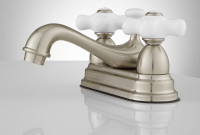Here is about bathroom sink plumbing: the parts, how it’s working, the diagram of assembly, and how to install the plumbing of bathroom sink drain. I hope this information help you. Check it out.
Read also: Bathroom Sink Drain Pipe Size
IMPORTANT PARTS OF BATHROOM SINK PLUMBING
1. Shutoff Valves
Shutoff valves is metal or plastic. The size is small. It is located between the supply hoses or tubes (this part is connected with the tailpieces on the sink faucet) and the incoming water supply pipes.
The shape of the handle shutoff valves in oval or sometimes spherical. The handle is work for open or close the valves. So, this shutoff valves are often called Stop Valves.
With this part, you no need to shutting off supply the water to the whole house. Because you only need use this shutoff valves to turn off the water supply at the sink only.
The shutoff valves are pairs. One for hot waters, and one for cold water. The installation is easy, because use compression fittings, so you install onto the water pipes without soldering. But, if you want to replace shutoff valve, you need to turn off the water to the house.

2. Supply Tubes
Usually, supply tubes made of chromed copper, solid plastic (gray), plastic mesh (usually white), or braided wire mesh. For supply tubes position, you can see from the sink faucet tailpieces then down to stop valves.
Supply tubes connected to shutoff valves and tailpieces with attached nuts. Sometimes, supply tubes fail. If that happen, you need replace it.
3. Drain Tailpiece
Drain tailpiece also called sink tailpiece is the straight part of pipe, and it’s connects to the sink drain fitting bottom. If you have pop-up drain sink, you can find on the back tailpiece to check the drain assembly.
Drain tailpiece using a slip nut to attached with drain fitting. It’s easy to controls. Under the nut you can find a tapered plastic washer that make a watertight seal.
If you drop item into the drain sink, you can open these slip-nut joints. Then you can take the item.

4. P-Trap
P-Trap have 2 parts, U-bend and trap arm. These parts make your sink connected to the sewer line. The curved trap allows your sink safety from holds standing water, also prevents the sewer gasses rising up and out to the sink.
The U-bend bottom always filled with water, so the gasses can not back to sink. If you run water to the drain, you always change the water in the U-bend with new water.
The P-trap easy to replace because using slip-nut joints to assemble it. But old design using solvent-glued, so better for you to change with trap with slip-nut joint.
5. Drain Pipe
This part is connected with the household plumbing system. Drain pipe connects to trap arm with slip-nut joint. So, the sink drain pipe easy to repairs.
The size of drain pipe is 1½ inch in diameter, but it can be larger or sometimes smaller.
Related post: Best Tips on How to Decorate a Small Bathroom Sink
HOW BATHROOM SINK PLUMBING WORKS
Usually, bathroom sink has 3 fixture holes: 4, 6, or 8 Inch centers. The larger size used to receive a split set faucet that faucet handles and the spout separated. 4 or 6 Inch for a center set faucet or a single lever faucet. The water flow from supply tubes to shutoff valves then to tailpieces on base of faucet.
Besides that, Pop-up stopper at the drain pipe bathroom sink plumbing that raises and lowers if you pull up or down on knob/handle that located behind the faucet body. The knob is head of lift rod that tied to a clevis (connecting bar).
Clevis connects to pivot rod and ball assembly, that consist of rod through rubber pivot ball. This part is slightly up to the tailpiece of stopper.
If you push the knob, the lift rod will down, and it cause pivot rod push the stopper will up. And the opposite will happen, if you pull the knob, you make the stopper down.
Because some reason, if you want to remove or replace assembly, you can pull it right out. Or, you maybe should to twist it to remove it from the clevis.
Bathroom sink drain has a flange. With plumber’s putty, the flange was sealed to the sink hole and screwed into drain body. And with a lock nut, it’s tightened to under the sink bowl.
And then how to P-Trap works, I explained above. Including how water is trapped and hinders the return of gases to the top.
Then, by observing the following bathroom sink plumbing diagram, it may be easier for you to understand how it works as a whole.
DIAGRAM OF PLUMBING BATHROOM SINK DRAIN ASSEMBLY

HOW TO INSTALL BATHROOM SINK PLUMBING
Generally, Installing bathroom sink plumbing is need two phases: rough-in and finishing phase. The rough-in is more difficult phase. It depends on the system’s configuration overall.
Bathroom sink no need high water volumes. So, we must be able to branch the ½ inch supply lines from the tub or shower.
After that, we can tie the 2-inch drain line into an existing one. Remember too about sink vent. If not, maybe it will not drain properly. We have to raise the 1 ½ or 2-inch vent from the drain within 5 feet of the sink trap. And don’t forget to tie into an existing vent or to the roof.
1. Installing the Bathroom Sink Plumbing Pipes
Important to know is the position of the supply tubes and drain pipes. Drain pipes and sink drain should be lined up, and straight between the supply stub outs.
Uncover the wall to pass the pipe out. The water must be off when the tees soldered onto the pipes.
The drain slope is ¼ inch per foot toward the sewer, and so does the vent in its incline toward its tie-in point.
After that, allow the stub-outs lengthwise a few inches from the wall, then close it after you install the sink.
2. The Stub-Outs Prepare
Install shutoff valves on the supply stub-outs before hook up the sink. Solder slip-joint valves to pipes or with a wrench, tighten on compression valves.
Gluing on the valves is the options if you using CPVC plastic pipes instead of copper ones. But, if you don’t glue the P-Trap to the waste pipe, you can glue on a P-Trap adapter.
3. Connecting the Sink
Install the faucet and the drain onto the sink before install the sink. It’s will be easier for you. Install tailpiece with same lever as the top of the drain. It’s makes the trap connects easily.
Connect the faucet supply hoses to the shutoff valves and faucet inlets. Then tighten with adjustable pliers. The connectors must be right at size to fit, so better you check before you buy it. If the pop-up stopper was connected, the sink ready to use.
Finally, its all of information for you about bathroom sink plumbing. If you want us to discuss further, please write in the comments column below.
Originally posted 2021-09-24 06:24:00.







